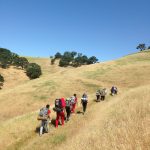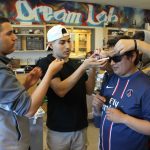Bay Area Inspire Awards: Build Your Own Computer Lab – Supporting Emerging Tech Leaders
Guest blog post by Samantha Solomon, 2018 Bay Area Inspire Awardee
At the start of 2018, Philanthropic Ventures Foundation (PVF) awarded grants to six young Bay Area residents with fresh ideas for building better communities. These awards were made possible through the Bay Area Inspire Awards, which provides $5,000 grants to 18-30 year olds living in San Francisco, Alameda, and San Mateo Counties. Below is a report written by one of these awardees, Samantha Solomon, who used her award to give students at LIFE Academy access to computers and provide students with the opportunity to better understand how computers work. Her project involved middle and high school students building their own computers, to be used for a computer lab in the library and as tools for those who want to learn coding and pursue more work with technology.
The Inspiration
In a state where 986,000 people were unemployed in September of 2017, it would seem that one of the best ways to equip kids for a choice-filled future is to make sure they are fluent in the skills and thinking associated with tech work. Regardless of what students’ goals are for themselves, it is our job as educators to make sure that students have access to the skill sets and knowledge that will allow them to enter college or the workforce in a competitive position – or better yet, give them the skills to execute their own unique vision of their lives. Public schools provide the opportunities and resources to support more people of color in accessing the widely available and lucrative tech work that exists in California.
Their absence is a missed opportunity for individuals and for their absent perspective in the workplace and products that exist.
BUT, we can’t just be educating students to become future tech workers – we need to be educating them to become future tech leaders. The students who are served by my library today need to be people on hiring committees, the people creating the culture, and the people mentoring the future students served by this library.


Building a Program
My original plan was for kids to work with different coding projects over several weeks, with a knowledgeable mentor. The culmination of this project would have been that teams would use the skills they’ve gained to pitch and create an app that solves a problem in their community. Teams would have several weeks to work on this project, with the support of the guest teacher. Teams would present their final projects at a community forum in evening event that will include parents and community members. I was interested in tracking changes in students’ point of view or thinking about the ways that they interact with technology and their roles as consumers/creators of tech products.
But plans change. We got started a LOT later than I had thought; instead of a knowledgeable mentor, they got me, and because of this we ran out of time to create anything on a larger scale. Things had to be drastically scaled back, but kids were still able to get a taste of what is to come the following year.
That said, I would still qualify the early parts of this project as a success. Much of that success is due to help from my Bay Area Inspire Awards mentor, Jayson Phillips. He connected me with the right tools, helped me test them, and gave feedback on the process.
Jayson introduced me to the Kano Computer kit.* It’s powered by a Raspberry Pi Processor (which I had originally planned to use), but it’s in a way more convenient and usable package, since it functions like a Chromebook when done.
After Jayson and I played with our prototype, I put out a computer for kids to use, and they were like moths to a flame.

They were able to figure out SO MUCH of how this computer works innately, especially to play games like the Hack Minecraft feature. But one thing we know is that you can’t assume digital literacy or competency, even in the generation we describe as digital natives.
I wanted kids to be able to opt into the program, so I sent out an email to school staff asking permission for interested students to miss advisory two times each week. The response was overwhelmingly positive and supportive.
We had our first Tech Leaders meeting, and each partner group got to build their own computer. Partners helped each other troubleshoot and also celebrated each other’s success.
Because things really got rolling later than I expected, our scope and sequence for the weeks we were able to meet was WAY abbreviated. The mini goal was for participating students to bring a friend they thought might be interest in coding and to showcase what they learned in a hands-on demo. But, as many of you know, school calendars can change suddenly, so we had to drop the showcase aspect. It was disappointing, but something that was totally out of my hands.
Next Steps
This pilot experience was a great learning opportunity. I plan to expand the Tech Leaders program in 2018-19 and apply what I have learned.
Three of my biggest learnings were:
1. Student Choice Matters – Let kids opt into an opportunity. Having participants who WANT to be there makes a huge difference. Every opportunity doesn’t appeal to every kid, and part of living a choice-filled life is being able to follow your passions. I was originally going to have teachers nominate/send advisees, but I am glad I chose to let kids sign up.
2. 30 minutes is not enough time. Due to the millions of things happening at the end of the school year, the only place I could fit tech leaders in the schedule was during afternoon advisory (3:00-3:30), twice per week. Even though we had “an hour” each week, two 30-minute work periods were not enough to get any kind of flow going.
3. Small & Deep is better than Huge & Shallow. As the Teach Leaders program moves forward, I would like to focus on going very deep into a project with a small number of students at a time. Right now, I think this is going to look like two semester-long rotations with 8-10 students.
With the support of Bay Area Inspire Awards and my mentor, I am excited to continue to develop this program and support the passions of my students.

The students I work with deserve the chance to showcase their brilliance.
*Full disclosure: PVF Executive Director James Higa is on the board of Kano, but he was not involved in this project or the Bay Area Inspire Awards program.





